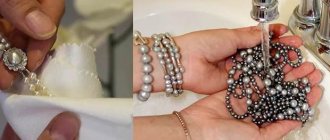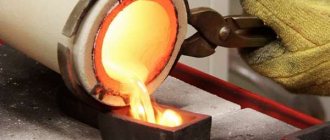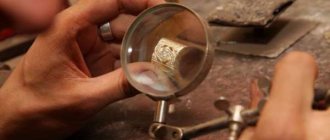The question of how to become a jeweler has been relevant for more than a hundred or even a thousand years - the ability to create elegant jewelry and work with precious metals and stones has been valued since the times of ancient civilizations. Of course, over the past centuries, learning methods have changed significantly: long-term “master-apprentice” relationships have been transformed into full-time and part-time educational programs, thanks to which you can reach a professional level in just a couple of years. In addition, the approach to the profession itself has changed to a certain extent: now not only those who see this as their profession are thinking about how to become a jewelry maker, but also those who are looking for an interesting hobby, in which they can also make good money. earn money.
What do those who want to become a jeweler need?
Of course, before signing up for courses or starting self-study, many people try to figure out what it takes to become a jeweler and how much everything will cost. In general, jewelry making includes three main areas: sketching, 3D modeling and direct work on the product (casting, processing, etc.).
So, you need to keep in mind that jewelry production requires a separate room with an exhaust hood. Most of the standard tools are sold in a regular hardware store: these are a jigsaw, a mallet, metal scissors, files and saws , pliers, wire cutters, calipers, etc. Of course, the master also has specific tools and devices in his arsenal, which are mainly needed for creating and processing injection molds - a steel plate for straightening and straightening, a mold, etc. You will become familiar with the complete list of what is required during the course.
For sketches you will need paper, pencils, watercolors, gouache, brushes. Wire, plasticine and glue will also be appropriate. 3D modeling is carried out on a computer. It may have average performance and not have the most powerful video card, the main thing is to install specialized programs on it, such as Rhinoceros 3D and ZBrush . In addition, Photoshop and CorelDRAW will be useful to the jeweler.
Thus, if the future master has a suitable premises, the most significant expense item at the initial stage will be the acquisition of the necessary tools, as well as the purchase of licensed software.
Peculiarities
A detailed description of the profession of a jeweler should begin with the fact that this is one of the most ancient crafts. Moreover, initially the master’s work was largely associated with the production of objects for religious and sacred purposes (at that time these included jewelry). Over time, many aspects have been transformed, but some things have remained virtually unchanged - for example, the personal qualities inherent in a jeweler. First of all, this is a combination of creativity and readiness for painstaking, routine work, as well as perseverance, a good eye, accuracy, and the presence of artistic abilities.
Interesting facts about the jeweler’s profession should be supplemented by the amount of knowledge that a good craftsman possesses. He makes sketches, composes compositions, works with metals, stones and other materials, and each area requires its own specific theoretical training and practical skills. Thus, a jeweler must know the laws of composition and compatibility of materials, be able to draw on paper and make 3D models on a computer. And of course, his responsibilities include working with metals, stones and much more.
Where can you become a jeweler?
It would seem that the World Wide Web has significantly expanded our opportunities for self-education: you can find any tutorials and begin to master this or that craft yourself. However, jewelry making is an area where you just need to improve your technique on your own , and it’s better to learn the basics and bring your skill to the required level with a teacher. Firstly, it has a full-fledged program that covers all aspects and directions, while with independent learning, the student, as a rule, draws up a program for himself. It is not so easy for a beginner to cope with this task, because it is difficult for him to assess the correctness and completeness of the selected material.
Secondly, when training under the supervision of an experienced master, you receive permanent feedback . The teacher will tell you what else needs to be worked on and will immediately point out mistakes, if any. Thirdly, there are also areas that are almost impossible to learn on your own. For example, for jewelry design it is very difficult to find specialized literature that would fully cover this area.
So, if you really want to master the craft of creating jewelry, the question is: “How to become a jeweler yourself?” should be replaced by the question: “Where should I go to become a jeweler?” And there are two main options: full-time and correspondence courses (online programs). Advantages of correspondence courses: lower price and the opportunity to study at home, at the most convenient time . The advantages of face-to-face courses: learning is faster and more efficient, there is always contact with the teacher and other students, you can discuss any issues, ask for advice or help.
Who is it suitable for?
The profession is one of the most in demand: jewelry salons constantly advertise vacancies, workshops for making and repairing jewelry are open in all cities. It’s not difficult to get a job, and what’s important for this is not so much a document about graduating from an educational institution, but rather a skill. Most craftsmen do not have higher education, and sometimes even any diploma or certificate. Salary depends on qualifications, region and place of work. On average, a beginning master earns 15-25,000 rubles per month. Experienced and famous jewelers can earn from 30,000 to 100,000. Higher earnings are available only in Moscow.
Where can I study to become a jeweler in Moscow?
Everyone who wants to become a jeweler, regardless of their training, is invited to the J-design.pro school of jewelry design. Both full-time and correspondence courses are organized here, which are designed in such a way that students step by step master all the skills of a professional jeweler and, upon completion of the program, can create their own products . Training lasts from six months (for entry-level) to two years (for professional level).
When forming the program, significant attention was paid not only to technical, but also to artistic aspects. Future masters are taught to think, analyze and evaluate, and are instilled with artistic taste. That is why students of full-time courses go with teachers to specialized exhibitions, where they get acquainted with products made by professionals and analyze them. The J-design.pro school provides students with everything they need to become a jeweler, start producing their own products and subsequently, possibly, open their own brand of exclusive jewelry.
Who it
The main task of a jeweler is to make jewelry.
Often, craftsmen also provide jewelry repair services, adjusting the sizes of rings, bracelets or chains. In jewelry factories or workshops, division of labor is accepted. Jewelers here are considered not only designers, but also foundry workers, loaders, assemblers who are responsible for the technical part of the work.
The specialist is helped in his work by many tools - jigsaws, files, soldering irons, magnifying glasses. Sometimes, when performing complex original works, completely new devices and mechanisms of original production are used.
In his craft, a jeweler uses precious and non-ferrous metals, precious and semi-precious stones. When creating an artistic product, common techniques include forging, casting, artistic embossing, carving or engraving.
Colleges and technical schools
Graduates of 9th grade can receive basic training at Moscow colleges and technical schools.
- Art and Industrial College named after Vasnetsov. Trains artists of decorative and applied arts. Training is conducted on a budget basis.
- College of Decorative and Applied Arts No. 36 named after Carl Faberge. The duration of training based on the 9th grade will be 3 years 5 months, the cost of the contract is from 68,000 rubles.
- Moscow educational complex. Offers to obtain the specialty “Jeweler”, duration of training is from 34 months, contract price from 120,000 rubles.
- College of Gzhel State University. It trains specialists for 46 months, there are 50 budget places. The contract price is from 92,000 rubles.
- College of Entrepreneurship No. 11. Specialists are trained on the basis of 9th and 11th grades, there are budget places.
What skills will be required?
There are many courses on the global network “How to become a jeweler” that offer training in the basics of craftsmanship. But before signing up for free and paid trainings, professionals recommend reading Erhard Brepohl’s book “Theory and Practice of Jewelry Making.” And also analyze your character and understand whether it has the following traits:
- perseverance, because manual work is very painstaking;
- curiosity - all jewelers are constantly improving their skills;
- analytical mind to study all the properties of alloys;
- creative spirit to create unique sketches;
- patience, because not everything works out the first time;
- the ability to sell your skills to get a job in the future or receive direct orders as a self-employed citizen.
Skills in working with a blowtorch, jigsaw and nail file will also come in handy if you want to work with the metal itself. Ability to work in 3D modeling programs when you decide to become a jewelry designer. As well as the ability to carefully and smoothly process stones when choosing to work with gems.
Where to begin
If you are asking this question and want to become a real professional in your field, then it makes sense to think about entering a secondary specialized or higher educational institution in the relevant specialty. In our country, this can be done both free and for a fee.
If you just want to be able to make jewelry for yourself and your loved ones, jewelry making courses are best for you. Here you will be taught the basics of the profession. Thus, you can feel like a real master even without special education.
Career prospects
During their studies, all Istituto Marangoni students collaborate with fashion houses in Italy, which gives them the opportunity to gain experience and make professional contacts. In addition, much attention is paid to management skills and market research - the university trains not just artisans, but proactive creators who are ready to put their ideas to work.
Based on the results of the training, the institute organizes public screenings and meetings with key industry players. For many, graduation is already the beginning of a successful career.
Interesting Facts
Jewelry craftsmanship has a rich history, during which many interesting events took place:
- A necklace made of mollusk shells is considered the oldest piece of jewelry : according to experts, the age of the product is at least 115 thousand years.
- The founder of the Cartier brand is the first master who used platinum to create jewelry. Previously, coins were mainly made from metal.
- Working with precious materials requires calmness and scrupulousness from craftsmen, therefore, before entering educational institutions, applicants are required to undergo examination by a narcologist and psychologist.
- The profession of a jeweler is considered hereditary , which is passed on from generation to generation - usually the fate of a child in such families is already predetermined from childhood.
- The most valuable jewelry is considered to be those found on the ocean floor after the Titanic disaster. The collection includes: necklaces, pins, brooches, rings and, of course, the most important thing – the “Heart of the Ocean” necklace, which can be seen on the heroine of James Cameron’s film.
- Due to its plasticity, gold quickly loses its shape, so it is never used in its pure form, but is alloyed with other metals.
- The dark blue Wittelsbach diamond is the most expensive in the world - its cost is approximately $80 million.
Jewelry craftsmanship is a real art. Despite the high work requirements and existing disadvantages, this profession remains one of the most in demand, creative and highly paid in the world.
Main directions
To study to become a jeweler, you need to choose a field of activity. It is impossible to master everything at once in any profession. The main specializations of the masters include:
- creating models of future products, preparing sketches and transferring them to a 3D version;
- casting, processing and mounting of metal precious parts of future works of jewelry;
- applying ornaments, patterns, fonts, engravings and other decorative elements;
- processing of precious stones and their fixation in products;
- creating designs using jewelry enamel, applying a special protective layer, spraying and working with colored clay.
Advice for beginners
Don't chase money, but do what you like. In any business, you can immediately see people for whom profit is more important. But there are those who do something because they love it and for whom the financial side of the issue comes into the background. I am convinced that if you follow the second path, then everything will be fine with profit. If you make a quality product, it will be successful in any case.
What do they do
The easiest option is to make pure craft
and create jewelry based on other people’s sketches, do repairs and adjustments.
If you add artistic vision to craft skills, seriously study applied and fine arts, design and 3D modeling, you can become a jewelry designer
and accessories. Often such people are required in large jewelry companies, especially many vacancies abroad.
An ordinary designer can eventually become a director of a department
or responsible for the product line.
Another option is to engage in expertise
and professionally evaluate finished products or stones.
The most talented and ambitious accessory designers create their own jewelry brands
.











